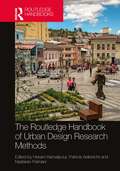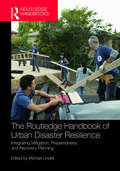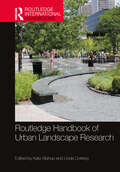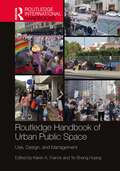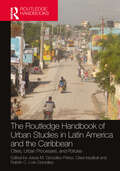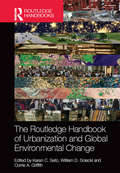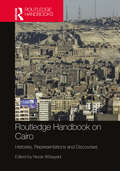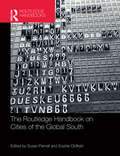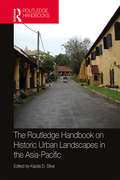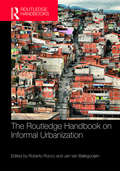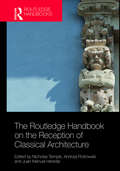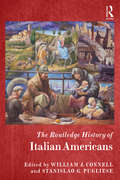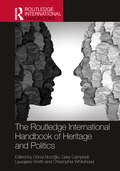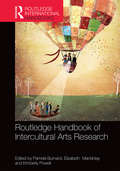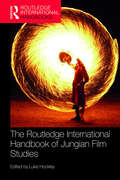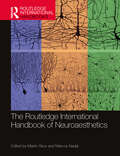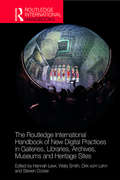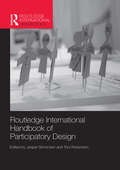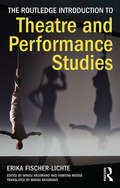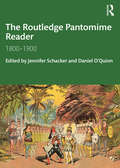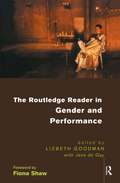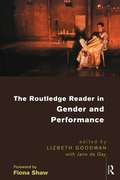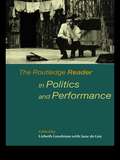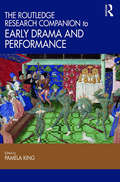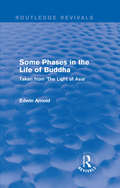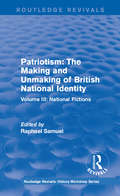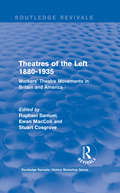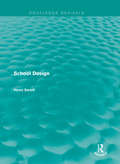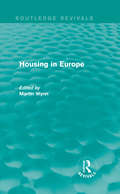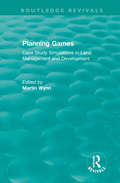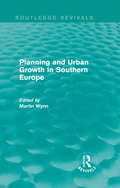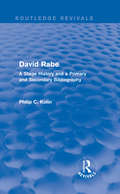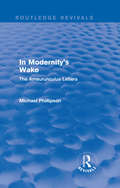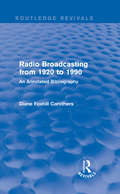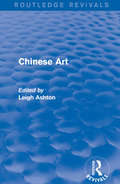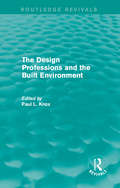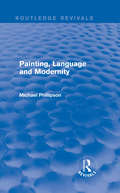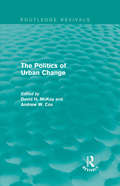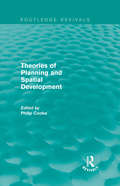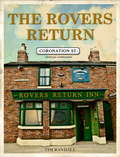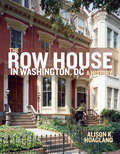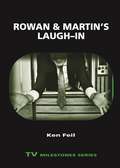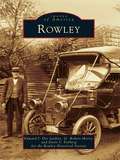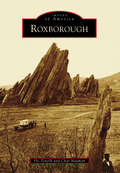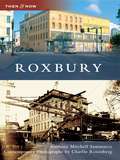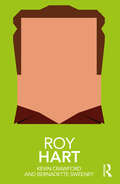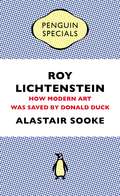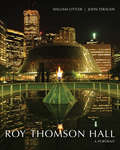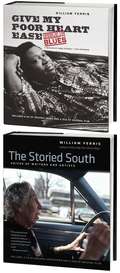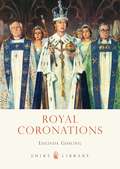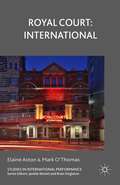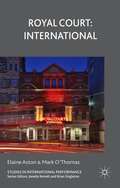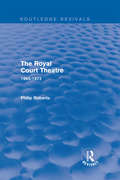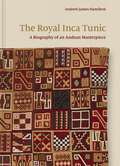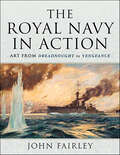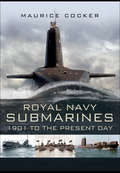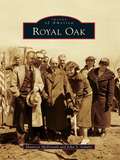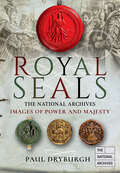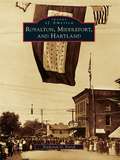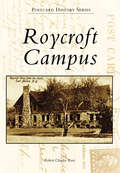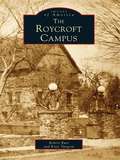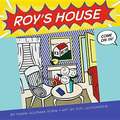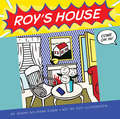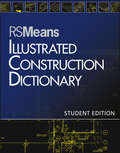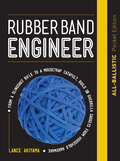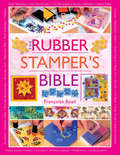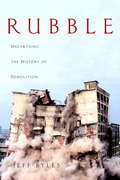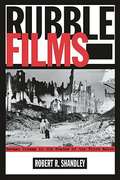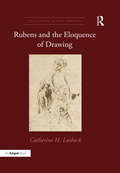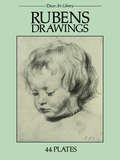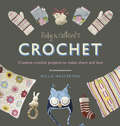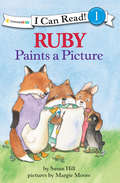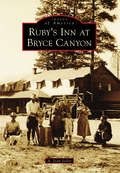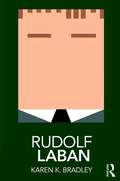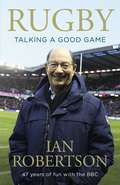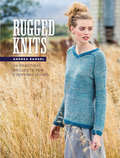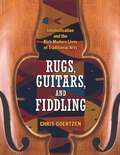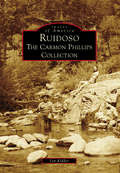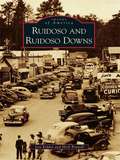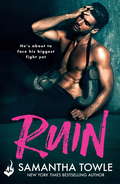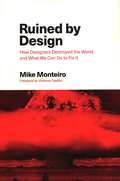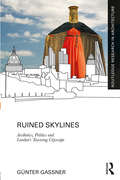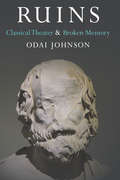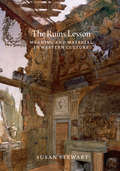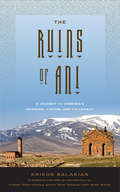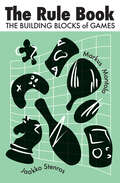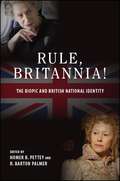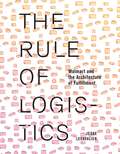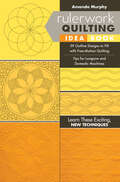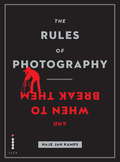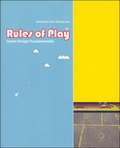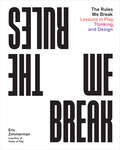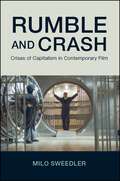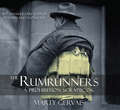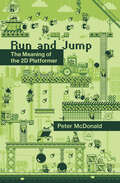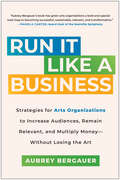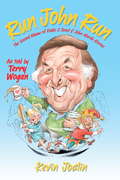- Table View
- List View
The Routledge Handbook of Urban Design Research Methods
by Hesam Kamalipour Patricia Aelbrecht Nastaran PeimaniAs an evolving and contested field, urban design has been made, unmade, and remade at the intersections of multiple disciplines and professions. It is now a decisive moment for urban design to reflect on its rigour and relevance. This handbook is an attempt to seize this moment for urban design to further develop its theoretical and methodological knowledge base and engage with the question of "what urban design can be" with a primary focus on its research. This handbook includes contributions from both established and emerging scholars across the global North and global South to provide a more field-specific entry point by introducing a range of topics and lines of inquiry and discussing how they can be explored with a focus on the related research designs and methods. The specific aim, scope, and structure of this handbook are appealing to a range of audiences interested and/or involved in shaping places and public spaces. What makes this book quite distinctive from conventional handbooks on research methods is the way it has been structured in relation to some key research topics and questions in the field of urban design regarding the issues of agency, affordance, place, informality, and performance. In addition to the introduction chapter, this handbook includes 80 contributors and 52 chapters organised into five parts. The commissioned chapters showcase a wide range of topics, research designs, and methods with references to relevant scholarly works on the related topics and methods.
The Routledge Handbook of Urban Disaster Resilience: Integrating Mitigation, Preparedness, and Recovery Planning
by Michael K. LindellThe Routledge Handbook of Urban Disaster Resilience emphasizes the intersection of urban planning and hazard mitigation as critical for community resilience, considering the interaction of social, environmental, and physical systems with disasters. The Handbook introduces and discusses the phases of disaster – mitigation, preparedness/response, and recovery – as well as each of the federal, state, and local players that address these phases from a planning and policy perspective. Part I provides an overview of hazard vulnerability that begins with an explanation of what it means to be vulnerable to hazards, especially for socially vulnerable population segments. Part II discusses the politics of hazard mitigation; the failures of smart growth placed in hazardous areas; the wide range of land development policies and their associated risk; the connection between hazards and climate adaptation; and the role of structural and non-structural mitigation in planning for disasters. Part III covers emergency preparedness and response planning, the unmet needs people experience and community service planning; evacuation planning; and increasing community capacity and emergency response in developing countries. Part IV addresses recovery from and adaption to disasters, with topics such as the National Disaster Recovery Framework, long-term housing recovery; population displacement; business recovery; and designs in disasters. Finally, Part V demonstrates how disaster research is interpreted in practice – how to incorporate mitigation into the comprehensive planning process; how states respond to recovery; how cities undertake recovery planning; and how to effectively engage the whole community in disaster planning. The Routledge Handbook of Urban Disaster Resilience offers the most authoritative and comprehensive coverage of cutting-edge research at the intersection of urban planning and disasters from a U.S. perspective. This book serves as an invaluable guide for undergraduate and postgraduate students, future professionals, and practitioners interested in urban planning, sustainability, development response planning, emergency planning, recovery planning, hazard mitigation planning, land use planning, housing and community development as well as urban sociology, sociology of the community, public administration, homeland security, climate change, and related fields.
Routledge Handbook of Urban Landscape Research (Routledge International Handbooks)
by Kate Bishop Linda CorkeryLandscape architecture is one of the key professions dedicated to making cities hospitable and healthy places to live, work and play, while respecting and enhancing the natural environments and landscapes we inhabit. This edited collection presents current writing about the pivotal roles that landscape architects play in addressing some of the most pressing problems facing the planet, its environments and its populations through their research, analysis and speculative practice. The book has assembled current writings on recent research structured around five major themes: governance, power and partnership; infrastructure, systems and performance; environment, resilience and climate change; people, place and design; and culture, heritage and identity. As a collection, the chapters demonstrate the diversity of themes and topics that are expanding the scholarly body of knowledge for the discipline and its relevance to the practice of landscape architecture. The contributors to this book are academic researchers and practitioners from the discipline of landscape architecture. The chapters draw on their research, teaching and experience as well as analysis of project examples. Fifty-two contributors from the United Stsates, United Kingdom, Sweden, Denmark, the Netherlands, Nigeria, Malaysia, Spain, Colombia, Australia, New Zealand and Canada discuss a diverse range of contemporary themes in urban landscape architecture. Collectively, the contributors demonstrate the breadth of experience, shared concerns and distinct issues that challenge urban landscape architecture and cities in the 21st century.
Routledge Handbook of Urban Public Space: Use, Design, and Management (Routledge International Handbooks)
by Karen A. FranckIs it truly the "end" of public space? This handbook presents evidence that the answer is "no". In cities in different parts of the world, people still use public space to pursue activities of their choice. The book is divided into seven sections. The first section presents three emerging types of public space. Each of the subsequent five sections focuses on a type of activity: recreation, commerce, protest, living and celebration. These sections are international in scope, presenting cases of activities in Brazil, China, Colombia, DR Congo, Egypt, Finland, Germany, Libya, Taiwan, Turkey and the U.S. The closing section, composed of three chapters, presents research methods for studying public space. Graduate students, faculty members and researchers in social science, architecture, landscape architecture, geography and urban design will find the book useful for understanding, studying and designing urban public space.
The Routledge Handbook of Urban Studies in Latin America and the Caribbean: Cities, Urban Processes, and Policies
by Jesús M. González-Pérez Clara Irazábal Rubén C. Lois-GonzálezThis handbook presents the great contemporary challenges facing cities and urban spaces in Latin America and the Caribbean. The content of this multidisciplinary book is organized into four large sections focusing on the histories and trajectories of urban spatial development, inequality and displacement of urban populations, contemporary debates on urban policies, and the future of the city in this region. Scholars of diverse origins and specializations analyze Latin American and Caribbean cities showing that, despite their diversity, they share many characteristics and challenges and that there is value in systematizing this knowledge to both understand and explain them better and to promote increasing equity and sustainability. The contributions in this handbook enhance the theoretical, empirical and methodological study of urbanization processes and urban policies of Latin America and the Caribbean in a global context, making it an important reference for scholars across the world. The book is designed to meet the interdisciplinary study and consultation needs of undergraduate and graduate students of architecture, urban design, urban planning, sociology, anthropology, political science, public administration, and more.
The Routledge Handbook of Urbanization and Global Environmental Change (Routledge International Handbooks)
by Karen C. Seto William D. Solecki Corrie A. GriffithThis volume provides a comprehensive overview of the interactions and feedbacks between urbanization and global environmental change. A key focus is the examination of how urbanization influences global environmental change, and how global environmental change in turn influences urbanization processes. It has four thematic foci: Theme 1 addresses the pathways through which urbanization drives global environmental change. Theme 2 addresses the pathways through which global environmental change affects the urban system. Theme 3 addresses the interactions and responses within the urban system in response to global environmental change. Theme 4 centers on critical emerging research.
Routledge Handbook on Cairo: Histories, Representations and Discourses
by Nezar AlSayyadThis Handbook simultaneously provides a single text that narrates the Cairo of yesterday and of today, and gives the reader a major reference to the best of Cairo scholarship. Divided into three parts covering Histories, Representations and Discourses of Cairo, the chapters provide comprehensive coverage of Cairo from both a disciplinary and an interdisciplinary point of view, with scholars from a great range of disciplines. Part One contains chapters on the history of specific parts of the city to provide both a concise picture of Cairo and an appreciation for the diversity of its constituent parts and periods. Part Two of the book deals with the various forms of representations of the city, from high-end literature to popular songs, and from photographs to films. Finally, Part Three covers current discourses about the city, comprising historical reflections on the city from the present, surveys of its current condition, analysis of it serious urban problems and visions for its future. The Routledge Handbook on Cairo provides a unique and innovative look at the ever-evolving state of Cairo. It will be a vital reference source for scholars and students of Middle Eastern Studies, Middle East History, Cultural Studies, Urban Studies, Architecture and Politics.
The Routledge Handbook on Cities of the Global South
by Susan Parnell Sophie OldfieldThe renaissance in urban theory draws directly from a fresh focus on the neglected realities of cities beyond the west and embraces the global south as the epicentre of urbanism. This Handbook engages the complex ways in which cities of the global south and the global north are rapidly shifting, the imperative for multiple genealogies of knowledge production, as well as a diversity of empirical entry points to understand contemporary urban dynamics. The Handbook works towards a geographical realignment in urban studies, bringing into conversation a wide array of cities across the global south – the ‘ordinary’, ‘mega’, ‘global’ and ‘peripheral’. With interdisciplinary contributions from a range of leading international experts, it profiles an emergent and geographically diverse body of work. The contributions draw on conflicting and divergent debates to open up discussion on the meaning of the city in, or of, the global south; arguments that are fluid and increasingly contested geographically and conceptually. It reflects on critical urbanism, the macro- and micro-scale forces that shape cities, including ideological, demographic and technological shifts, and constantly changing global and regional economic dynamics. Working with southern reference points, the chapters present themes in urban politics, identity and environment in ways that (re)frame our thinking about cities. The Handbook engages the twenty-first-century city through a ‘southern urban’ lens to stimulate scholarly, professional and activist engagements with the city.
The Routledge Handbook on Historic Urban Landscapes in the Asia-Pacific (Routledge International Handbooks)
by Kapila SilvaThe Routledge Handbook on Historic Urban Landscapes in the Asia-Pacific sheds light onto the balancing act of urban heritage management, focusing specifically on the Asia-Pacific regions in which this challenge is imminent and in need of effective solutions. Urban heritage, while being threatened amid myriad forces of global and ecological change, provides a vital social, cultural, and economic asset for regeneration and sustenance of liveability of inhabited urban areas worldwide. This six-part volume takes a critical look at the concept of Historic Urban Landscapes, the approach that UNESCO promotes to achieve holistic management of urban heritage, through the lens of issues, prospects, and experiences of urban regeneration of the selected geo-cultural context. It further discusses the difficult task that heritage managers encounter in conceptualizing, mapping, curating, and sustaining the plurality, poetics, and politics of urban heritage of the regions in question. The connective thesis that weaves the chapters in this volume together reinforces for readers that the management of urban heritage considers cities as dynamic entities, palimpsests of historical memories, collages of social diversity, territories of contested identities, and sites for sustainable liveability. Throughout this edited collection, chapters argue for recognizing the totality of the eco-cultural urban fabric, embracing change, building social cohesion, and initiating strategic socio-economic progress in the conservation of Historic Urban Landscapes. Containing thirty-seven contributions written by leading regional experts, and illustrated with over 200 black and white images and tables, this volume provides a much-needed resource on Historic Urban Landscapes for students, scholars, and researchers.
The Routledge Handbook on Informal Urbanization
by Roberto Rocco Jan Van BallegooijenThe Routledge Handbook on Informal Urbanization investigates the mutual relationship between the struggle for political inclusion and processes of informal urbanization in different socio-political and cultural settings. It seeks a middle ground between two opposing perspectives on the political meaning of urban informality. The first, the ‘emancipatory perspective’, frames urban informality as a practice that fosters autonomy, entrepreneurship and social mobility. The other perspective, more critical, sees informality predominantly as a result of political exclusion, inequality, and poverty. Do we see urban informality as a fertile breeding ground for bottom-up democracy and more political participation? Or is urban informality indeed merely the result of a democratic deficit caused by governing autocratic elites and ineffective bureaucracies? This book displays a wide variety of political practices and narratives around these positions based on narratives conceived upon specific case cities. It investigates how processes of urbanization are politicized in countries in the Global South and in transition economies. The handbook explores 24 cities in the Global South, as well as examples from Eastern Europe and East Asia, with contributions written by a global group of scholars familiar with the cases (often local scholars working in the cities analyzed) who offer unique insight on how informal urbanization can be interpreted in different contexts. These contributions engage the extreme urban environments under scrutiny which are likely to be the new laboratories of 21st-century democracy. It is vital reading for scholars, practitioners, and activists engaged in informal urbanization.
The Routledge Handbook on the Reception of Classical Architecture
by Nicholas Temple Andrzej Piotrowski Juan Manuel HerediaThis is the first comprehensive study of the reception of classical architecture in different regions of the world. Exploring the impact of colonialism, trade, slavery, religious missions, political ideology and intellectual/artistic exchange, the authors demonstrate how classical principles and ideas were disseminated and received across the globe. By addressing a number of contentious or unresolved issues highlighted in some historical surveys of architecture, the chapters presented in this volume question long-held assumptions about the notion of a universally accepted ‘classical tradition’ and its broadly Euro-centric perspective. Featuring thirty-two chapters written by international scholars from China, Europe, Turkey, North America, Mexico, Australia and New Zealand, the book is divided into four sections: 1) Transmission and re-conceptualisation of classical architecture; 2) Classical influence through colonialism, political ideology and religious conversion; 3) Historiographical surveys of geographical regions; and 4) Visual and textual discourses. This fourfold arrangement of chapters provides a coherent structure to accommodate different perspectives of classical reception across the world, and their geographical, ethnographic, ideological, symbolic, social and cultural contexts. Essays cover a wide geography and include studies in Italy, France, England, Scotland, the Nordic countries, Greece, Austria, Portugal, Romania, Germany, Poland, India, Singapore, China, the USA, Mexico, Brazil, New Zealand and Australia. Other essays in the volume focus on thematic issues or topics pertaining to classical architecture, such as ornament, spolia, humanism, nature, moderation, decorum, heresy and taste. An essential reference guide, The Routledge Handbook on the Reception of Classical Architecture makes a major contribution to the study of architectural history in a new global context.
The Routledge History of Italian Americans (Routledge Histories)
by William J. Connell Stanislao G. PuglieseThe Routledge History of Italian Americans weaves a narrative of the trials and triumphs of one of the nation’s largest ethnic groups. This history, comprising original essays by leading scholars and critics, addresses themes that include the Columbian legacy, immigration, the labor movement, discrimination, anarchism, Fascism, World War II patriotism, assimilation, gender identity and popular culture. This landmark volume offers a clear and accessible overview of work in the growing academic field of Italian American Studies. Rich illustrations bring the story to life, drawing out the aspects of Italian American history and culture that make this ethnic group essential to the American experience.
The Routledge History of Italian Americans (Routledge Histories)
by William Connell Stanislao PuglieseThe Routledge History of Italian Americans weaves a narrative of the trials and triumphs of one of the nation’s largest ethnic groups. This history, comprising original essays by leading scholars and critics, addresses themes that include the Columbian legacy, immigration, the labor movement, discrimination, anarchism, Fascism, World War II patriotism, assimilation, gender identity and popular culture. This landmark volume offers a clear and accessible overview of work in the growing academic field of Italian American Studies. Rich illustrations bring the story to life, drawing out the aspects of Italian American history and culture that make this ethnic group essential to the American experience.
The Routledge International Handbook of Heritage and Politics (Routledge Handbooks on Museums, Galleries and Heritage)
by Gönül Bozoğlu Gary Campbell Laurajane Smith Christopher WhiteheadThe Routledge International Handbook of Heritage and Politics surveys the intersection of heritage and politics today and helps elucidate the political implications of heritage practices. It explicitly addresses the political and analyses tensions and struggles over the distribution of power. Including contributions from early-career scholars and more established researchers, the Handbook provides global and interdisciplinary perspectives on the political nature, significance and consequence of heritage and the various practices of management and interpretation. Taking a broad view of heritage, which includes not just tangible and intangible phenomena, but the ways in which people and societies live with, embody, experience, value and use the past, the volume provides a critical survey of political tensions over heritage in diverse social and cultural contexts. Chapters within the book consider topics such as: neoliberal dynamics; terror and mobilisations of fear and hatred; old and new nationalisms; public policy; recognition; denials; migration and refugeeism; crises; colonial and decolonial practice; communities; self- and personhood; as well as international relations, geopolitics, soft power and cooperation to address global problems.The Routledge International Handbook of Heritage and Politics makes an intervention into the theoretical debate about the nature and role of heritage as a political resource. It is essential reading for academics and students working in heritage studies, museum studies, politics, memory studies, public history, geography, urban studies and tourism.
The Routledge International Handbook of Intercultural Arts Research (Routledge International Handbooks of Education)
by Kimberly Powell Elizabeth Mackinlay Pamela BurnardFor artists, scholars, researchers, educators and students of arts theory interested in culture and the arts, a proper understanding of the questions surrounding ‘interculturality’ and the arts requires a full understanding of the creative, methodological and interconnected possibilities of theory, practice and research. The International Handbook of Intercultural Arts Research provides concise and comprehensive reviews and overviews of the convergences and divergences of intercultural arts practice and theory, offering a consolidation of the breadth of scholarship, practices and the contemporary research methodologies, methods and multi-disciplinary analyses that are emerging within this new field.
The Routledge International Handbook of Jungian Film Studies (Routledge International Handbooks)
by Luke HockleyThe Routledge International Handbook of Jungian Film Studies weaves together the various strands of Jungian film theory, revealing a coherent theoretical position underpinning this exciting recent area of research, while also exploring and suggesting new directions for further study. The book maps the current state of debates within Jungian orientated film studies and sets them within a more expansive academic landscape. Taken as a whole, the collection shows how different Jungian approaches can inform and interact with a broad range of disciplines, including literature, digital media studies, clinical debates and concerns. The book also explores the life of film outside cinema - what is sometimes termed ‘post-cinema’ - offering a series of articles exploring Jungian approaches to cinema and social media, computer games, mobile screens, and on-line communities. The Routledge International Handbook of Jungian Film Studies represents an essential resource for students and researchers interested in Jungian approaches to film. It will also appeal to those interested in film theory more widely, and in the application of Jung’s ideas to contemporary and popular culture.
The Routledge International Handbook of Neuroaesthetics (Routledge International Handbooks)
by Martin Skov Marcos NadalThe Routledge International Handbook of Neuroaesthetics is an authoritative reference work that provides the reader with a wide-ranging introduction to this exciting new scientific discipline. The book brings together leading international academics to offer a well-balanced overview of this burgeoning field while addressing two questions central to the field: how the brain computes aesthetic appreciation for sensory objects and how art is created and experienced. The editors, Martin Skov and Marcos Nadal, have compiled a neuroscientific, physiological, and psychological overview of the systems underlying the evaluation of sensory objects and aesthetic appreciation. Covering a variety of art forms mediated by vision, audition, movement, and language, the handbook puts forward a critical review of the current research to explain how and why perceptual and emotional processes are essential for art production. The work also unravels the interaction of art with expectations, experience and knowledge and the modulation of artistic appreciation through social and contextual settings, eventually bringing to light the potential of art to influence mental states, health, and well-being. The concepts are presented through research on the neural processes enabling artistic creativity, artistic expertise, and the evolution of symbolic cognition. This handbook is a compelling read for anyone interested in making a first venture into this exciting new area of study and is best suited for students and researchers in the fields of neuroaesthetics, perceptual learning, and cognitive psychology.
The Routledge International Handbook of New Digital Practices in Galleries, Libraries, Archives, Museums and Heritage Sites (Routledge International Handbooks)
by Hannah Lewi Wally Smith Dirk Vom Lehn Steven CookeThe Routledge International Handbook of New Digital Practices in Galleries, Libraries, Archives, Museums and Heritage Sites presents a fascinating picture of the ways in which today's cultural institutions are undergoing a transformation through innovative applications of digital technology. With a strong focus on digital design practice, the volume captures the vital discourse between curators, exhibition designers, historians, heritage practitioners, technologists and interaction designers from around the world. Contributors interrogate how their projects are extending the traditional reach and engagement of institutions through digital designs that reconfigure the interplay between collections, public knowledge and civic society. Bringing together the experiences of some of today’s most innovative cultural institutions and thinkers, the Handbook provides refreshingly new ideas and directions for the exciting digital challenges and opportunities that lie ahead. As such, it should be essential reading for academics, students, designers and professionals interested in the production of culture in the post-digital age.
Routledge International Handbook of Participatory Design (Routledge International Handbooks)
by Jesper Simonsen Toni RobertsonParticipatory design is about the direct involvement of people in the co-design of the technologies they use. Its central concern is how collaborative design processes can be driven by the participation of the people affected by the technology designed. Embracing a diverse collection of principles and practices aimed at making technologies, tools, environments, businesses, and social institutions more responsive to human needs, the International Handbook of Participatory Design is a state-of-the-art reference handbook for the subject. The Handbook brings together a multidisciplinary and international group of highly recognized and experienced experts to present an authoritative overview of the field and its history and discuss contributions and challenges of the pivotal issues in participatory design, including heritage, ethics, ethnography, methods, tools and techniques and community involvement. The book also highlights three large-scale case studies which show how participatory design has been used to bring about outstanding changes in different organizations. The book shows why participatory design is an important, highly relevant and rewarding area for research and practice. It will be an invaluable resource for students, researchers, scholars and professionals in participatory design.
The Routledge Introduction to Theatre and Performance Studies
by Erika Fischer-Lichte Minou Arjomand Ramona MosseErika Fischer-Lichte's introduction to the discipline of Theatre and Performance Studies is a strikingly authoritative and wide ranging guide to the study of theatre in all of its forms. Its three-part structure moves from the first steps in starting to think about performance, through to the diverse and interrelated concerns required of higher-level study: Part 1 - Central Concepts for Theatre and Performance Research - introduces the language and key ideas that are used to discuss and think about theatre: concepts of performance; the emergence of meaning; and the theatrical event as an experience shared by actors and spectators. Part 1 contextualizes these concepts by tracing the history of Theatre and Performance Studies as a discipline. Part 2 - Fields, Theories and Methods - looks at how to analyse a performance and how to conduct theatre-historiographical research. This section is concerned with the 'doing' of Theatre and Performance Studies: establishing and understanding different methodological approaches; using sources effectively; and building theoretical frameworks. Part 3 - Pushing Boundaries - expands on the lessons of Parts 1 and 2 in order to engage with theatre and performance in a global context. Part 3 introduces the concept of 'interweaving performance cultures'; explores the interrelation of theatre with the other arts; and develops a transformative aesthetics of performance. Case studies throughout the book root its theoretical discussion in theatrical practice. Focused accounts of plays, practitioners and performances map the development of Theatre and Performance Studies as an academic discipline, and of the theatre itself as an art form. This is the most comprehensive and sophisticated introduction to the field available, written by one of its foremost scholars.
The Routledge Pantomime Reader: 1800-1900
by Jennifer SchackerThe Routledge Pantomime Reader is the first anthology to document this entertainment genre—one of the most distinctive and ubiquitous in nineteenth-century Britain. Across ten different shows, readers witness pantomime’s development from a highly improvisational venue for clowning, dance, and musical parody to a complex amalgamation of physical and topical comedy, stage wizardry, scenic spectacle, satire, and magical mayhem. Combining well-known tales such as "Cinderella", "Aladdin", and "Jack and the Beanstalk" with the lesser-known plotlines of "Peter Wilkins" and "The Prince of Happy Land", the book demonstrates not only how popular narratives were adapted to the current moment, but also how this blend of high and low entertainment addressed a whole range of social and cultural anxieties. Along with carefully annotated scripts, readers will find detailed introductions to all of the collected pantomimes and supplementary materials such as reviews, reminiscences, and a host of visual materials that bring these neglected entertainments to life. The plays collected here provide a remarkable perspective on the history of sexuality, class, and race during a period of vast imperial expansion and important social upheaval in Britain itself—essential reading for students and scholars of theatre history and popular performance.
The Routledge Reader in Gender and Performance
by Lizbeth Goodman Jane De GayThe Routledge Reader in Gender and Performance presents the most influential and widely-known, critical work on gender and performing arts, together with exciting and provocative new writings. It provides systematically arranged articles to guide the reader from topic to topic, and specially linked articles by scholars and teachers to explain key issues and put the extracts in context. This comprehensive volume:* reviews women's contributions to theatre history* includes contributions from many of the top academics in this discipline* examines how theatre has represented women over the centuries* introduces readers to major theoretical approaches and more complex questions about gender, the body and cross-dressing* offers an international perspective, including material from post-apartheid South Africa and post-communist Russia.
Routledge Reader in Gender and Performance
by Lizbeth Goodman Jane De GayThe book presents some of the most influential and widely known work on gender and performing arts, together with exciting and provocative new writings in the field.
The Routledge Reader in Politics and Performance
by Jane De Gay Lizbeth GoodmanThe Routledge Reader in Politics and Performance brings together for the first time a comprehensive collection of extracts from key writings on politics, ideology, and performance. Taking an interdisciplinary approach to the subject, and including new writings from leading scholars, the book provides material on: * post-coloniality and performance theory and practice * critical theories and performance * intercultural perspectives * power, politics and the theatre * sexuality in performance * live arts and the media * theatre games.
The Routledge Research Companion to Early Drama and Performance (Routledge Companions)
by Pamela KingThe study of early drama has undergone a quiet revolution in the last four decades, radically altering critical approaches to form, genre, and canon. Drawing on disciplines from art history to musicology and reception studies, The Routledge Research Companion to Early Drama and Performance reconsiders early "drama" as a mixed mode entertainment best studied not only alongside non-dramatic texts, but also other modes of performance. From performance before the playhouse to the afterlife of medieval drama in the contemporary avant-garde, this stunning collection of essays is divided into four sections: Northern European Playing before the Playhouse; Modes of Production and Reception; Reviewing the Anglophone Tradition; The Long Middle Ages Offering a much needed reassessment of what is generally understood as "English medieval drama", The Routledge Research Companion to Early Drama and Performance provides an invaluable resource for both students and scholars of medieval studies.
Routledge Revivals: Taken from 'The Light of Asia' (Routledge Revivals)
by Edwin ArnoldFirst published in 1915, this book presents a dramatization of part ofthe author's The Light of Asia. The original text represents one of the first successful attempts to popularise Buddhism and its founder Gautama Buddha — presenting his life, teachings and philosophy in verse poetry. This adaptation dramatizes part of the The Light of Asia and includes staging instructions, properties required, illustrative drawings of suggested costumes, and incidental music composed specifically for the piece. This book will be of interest to students of Indian and Buddhist literature — and how this has interacted with the West — as well as students of drama.
Routledge Revivals: Volume III: National Fictions (Routledge Revivals: History Workshop Series)
by Raphael SamuelFirst published in 1989, this is the third of three volumes exploring the changing notions of patriotism in British life from the thirteenth century to the late twentieth century and constitutes an attempt to come to terms with the power of the national idea through a historically informed critique. This volume studies some of the leading figures of national myth, such as Britannia and John Bull. One group of essays looks at the idea of distinctively national landscape and the ways in which it corresponds to notions of social order. A chapter on the poetry of Edmund Spenser explores metaphorical representations of Britain as a walled garden, and the idea of an enchanted national space is taken up in a series of essays on literature, theatre and cinema. An introductory piece charts some of the startling changes in the image of national character, from the seventeenth-century notion of the English as the most melancholy people in Europe, to the more uncertain and conflicting images of today.
Routledge Revivals: Workers' Theatre Movements in Britain and America (Routledge Revivals: History Workshop Series #5)
by Raphael Samuel Ewan Maccoll Stuart CosgroveFirst published in 1985, this book examines how workers theatre movements intended their performances to be activist — perceiving art as a weapon of struggle and enlightenment — and an emancipatory act. An introductory study relates left-wing theatre groupings to the cultural narratives of contemporary British socialism. The progress of the Workers’ Theatre Movement (1928-1935) is traced from simple realism to the most brilliant phase of its Russian and German development alongside which the parallel movements in the United States are also examined. A number of crucial texts are reprints as well as stage notes and glimpses of the dramaturgical controversies which accompanied them.
Routledge Revivals: School Design (1994) (Routledge Revivals)
by Henry SanoffEducators often overlook the positive impact of changing the environment of the school itself when considering how to improve the quality of education. First published in 1994, School Design shows how to create more effective schools through a design process that involves teachers, students, parents, administrators, and architects. It reveals how to create school environments that develop the whole child, instil enthusiasm for learning, and encourage positive social relationships. Readers discover how to integrate design research, design participation, and design development to optimize school settings. Using a number of case studies, detailed practical methods show how to: Link behavioural objectives to spatial needs Achieve spatial efficacy without compromising education Match children’s developmental needs to facility requirements Promote greater variety in physical facilities to accommodate various teaching and learning styles Gain more valuable feedback from teachers, parents, students, and local citizens on building performance. In response to tight school budgets, Henry Sanoff discusses how relatively minor design modifications can have a major positive effect on school performance. This path-breaking volume will provide architects, teachers, and school administrators with a wide array of insights into creating spaces that promote better learning.
Routledge Revivals: Housing In Europe (1984) (Routledge Revivals)
by Martin WynnFirst published in 1984, this book presents a survey of housing problems in various European countries and how individual states have responded. Each chapter begins by surveying the problem in each country since the Second World War, before going on to outline the roles fulfilled by national housing agencies and local authorities, as well as assessing the impact of housing policies on society and on the physical shape of cities. It considers whether housing policies have succeeded or failed and how the ‘housing problem’ has changed over time. Each chapter draws out lessons that can be learned for the future from each country’s past handling of the problem. This book will be a useful reference for those interested in housing, including planners, geographers, economists, sociologists or policy-makers.
Routledge Revivals: Case Study Simulations in Land Management and Development (Routledge Revivals)
by Martin WynnFirst published in 1985, this book presents seven games for use in the teaching and study of planning, urban studies or land administration. These simulations are all built on researched case studies and deal with a number of critical planning and developmental issues; for each one the book provides full operational instructions and all gaming materials required. The games in this volume cover a number of scenarios, including the design of a mixed retail, social and service centre in a new city, new development in a run-down inner city area, rehabilitation or renewal of housing, tourist development in the Mediterranean and a new cross-town motorway in a major north American city. In addition, sets of guidelines for those wishing to design and operate their own case study simulations are also included. This book will be a valuable resource for students of town planning or urban development who are keen to gain ‘hands-on’ experience of using the professional skills they have acquired on their courses.
Routledge Revivals: Planning And Urban Growth In Southern Europe (1984) (Routledge Revivals)
by Martin WynnFirst published in 1984, this book addresses key questions about the pattern of urban development in Southern Europe and the mechanisms employed to control and regulate this development in individual countries. It examines five countries – Greece, Italy, Portugal, Spain and Turkey – that have experienced different scales and rates of urbanization and industrialization. It identifies common problems arising from these processes, as well as the successes and failures of the planning policies employed to regulate development. This book will be of great value to geographers interested in Southern Europe and urban and regional planners interested in comparative patterns of development.
Routledge Revivals (1988): A Stage History and a Primary and Secondary Bibliography
by Philip C. KolinIn the twenty years that preceded the publication of this book in 1988, David Rabe was in the vanguard of playwrights who shaped American theatre. As the first full-length work on Rabe, this book laid the groundwork for later critical and biographical studies. The first part consists of an essay that covers three sections: a short biography, a summary and evaluation of his formative journalism for the New Haven Register, and a detailed and cohesive stage history of his work. The second part presents the most comprehensive and authoritative primary bibliography of Rabe to date, with the third section containing a secondary bibliography — including a section on biographical studies.
Routledge Revivals (1989): The Ameurunculus Letters
by Michael PhillipsonFirst published in 1988, this book attempts to tackle the problem of how to write about art, culture, and the issues of postmodernism in a style appropriate to what is being claimed. The letters are written on art’s behalf to a range of institutions and individuals, and have as their recurring concern the relation between art, culture and representation — both art as representation and how art is represented to, and for, the surrounding culture. They explore the context and viability of art through a range of themes, including writing, the aestheticisation of everyday life, style, design pleasure, fragmentation, hyphenation, technology, and the museum — drawing on materials from the visual arts, music, literature, post-structuralism, contemporary criticism, philosophy, and sociology.
Routledge Revivals (1991): An Annotated Bibliography
by Diane Foxhill CarothersFirst published in 1991, this book presents a comprehensive annotated bibliography of radio broadcasting. Its eleven chapter-categories cover almost the entire range of radio broadcasting — with the exception of radio engineering due to its technical complexity although some of the historical volumes do encompass aspects, thus providing background material. Entries are primarily restricted to published books although a number of trade journals and periodicals are also included. Each entry includes full bibliographic information, including the ISBN or ISSN where available, and an annotation written by the author with the original text in hand.
Routledge Revivals: Chinese Art (1935)
by Leigh AshtonFirst published in 1935, this book was intended to provide westerners with a more definite and comprehensive understanding of Chinese Art and its achievements. Newly available opportunities to study authentic examples, such as the Royal Academy exhibition that provided the impetus for this volume, allowed for greater opportunities to conduct in-depth examination than had previously been possible. Following an introduction giving an overview of Chinese art and its history in the west, six chapters cover painting and calligraphy, sculpture and lacquer, ‘the potter’s art’, bronzes and cloisonné enamel, jades, and textiles — supplemented by a chronology of Chinese epochs, a selected bibliography and 25 images.
Routledge Revivals: The Design Professions and the Built Environment (Routledge Revivals)
by Paul L. KnoxFirst published in 1988, this book argues that discussions of urban development often neglect to consider that much of the urban environment is designed by architects and planners, and that the particular world-view of architects and planners is crucial for the way proposals are taken up, modified and carried out. The author explores the world-view of architects and planners, considering their approach to design and the factors which influence this — work patterns, career paths and the firms in which they operate. The author also studies their place in the political decision-making process as it affects urban questions and then explores how architects and planners roles are changing.
Routledge Revivals: Painting, Language and Modernity (1985)
by Michael PhillipsonFirst published in 1985, this book draws together the author’s artistic with analytical practices which had been developed over many years of sociological enquiry. It interprets a ‘work of art’ as a site on which a viewer or critic is invited to share in questioning celebration of the painting itself. The author reassesses modern painting’s relation to its own origins and to tradition in light of the emergence of ‘postmodern’ practice — exploring its engagement of fundamental questions about language and being. Also assessed is the relevance of the metaphors of writings and Reading to an understanding of painting and viewing practices — looking at painters’ writings as well as phenomenological and post-structuralist writers.
Routledge Revivals: The Politics of Urban Change (1979)
by David H. McKay Andrew W. CoxFirst published in 1979, this book examines key planning policy areas such as land use planning, land values, housing and slum clearance, urban transport, industrial and regional economic location policies, and policies inner city policies to explain why particular policies have been adopted at particular times — assessing the role of political parties, bureaucrats and interests in setting the national policy agenda. Policy is also placed in the broader economic and social context and the question of whether, given contemporaneous constraints, a coherent national urban policy is possible is examined. Its focus on political parties’ role in urban change at the start of Thatcher-era upheavals makes this book especially valuable to students of urban sociology and the history of planning.
Routledge Revivals: Theories of Planning and Spatial Development (Routledge Revivals)
by Philip CookeFirst published in 1983, this book attempts to unify two bodies of theory which had become severely disjointed. Theories of the planning process had become detached from those of the urban and regional processes which are the subject of planning intervention. The author argues that major weaknesses of planning intervention in cities and regions have resulted from this split, and shows how it is possible to develop an integrated theory of the relationship between planning and spatial development. The mechanism which helps to unify the two fields is the division of labour. This poses problems for the planning system as its spatial requirements change but it depends upon the state planning framework in order to overcome those obstacles — hindering its capacity for spatial reorganisation. This book offers a thorough analysis of these obstacles and requirements by references to contemporaneous theoretical advances in the study of the development process, the state (especially at sub-national level), and the labour market. It is argued that the way capital makes use of urban and regional space can be explained by using the theoretical framework which is developed and, on this basis, point to certain innovative ways in which the processes underlying urban and regional de-industrialisation may be countered.
The Rovers Return: The Rovers Return Story
by Tim RandallCoronation Street is the world's longest-running TV soap-opera and a hugely popular national institution. From the moment the very first episode flickered onto our screens on 9 December 1960, the very heart of the show has always been the Rovers Return public house. It may just be a backstreet boozer, but TV's most famous pub has been at the centre of the action week in week out for the last 53 years. As longest-serving barmaid Betty once sagely noted: 'If you're not being talked about in this pub, you're not worth serving', and under the watchful eye of legendary landladies such as Annie Walker, Bet Lynch and Liz McDonald, the Rovers has witnessed everything from births, deaths, brawls and break-ups, to weddings, wakes and even its own ghost. But despite any drama that may be about to unfold, regulars are guaranteed a warm welcome, a shoulder to cry on and more often than not the waft of a hearty hotpot seeping through from the kitchen out back. This year proved to be the Rovers' most explosive to date when the pub was ripped apart by a devastating blaze, rocking the lives of the residents forever. As the boozer was gradually restored to its former glory, it hit home to the regulars just how much the heart of their community really meant to them... Including exclusive access to the Coronation Street archives, THE ROVERS RETURN STORY celebrates over five decades of tears and laughter inside Weatherfield's iconic watering hole. It's the book no fan would want to be without.
The Row House in Washington, DC: A History
by Alison K. HoaglandWith The Row House in Washington, DC, the architectural historian and preservationist Alison Hoagland turns the lucid prose style and keen analytical skill that characterize all her scholarship to the subject of the Washington row house. Row houses have long been an important component of the housing stock of many major American cities, predominantly sheltering the middle classes comprising clerks, tradespeople, and artisans. In Washington, with its plethora of government workers, they are the dominant typology of the historical city. Hoagland identifies six principal row house types—two-room, L-shaped, three-room, English-basement, quadrant, and kitchen-forward—and documents their wide-ranging impact, as sources of income and statements of attainment as well as domiciles for nuclear families or boarders, homeowners or renters, long tenancy or short stays. Through restrictive covenants on some house sales, they also illustrate the pervasive racism that has haunted the city. This topical study demonstrates at once the distinctive character of the Washington row house and the many similarities it shares with row houses in other mid-Atlantic cities. In a broader sense, it also shows how urban dwellers responded to a challenging concatenation of spatial, regulatory, financial, and demographic limitations, providing a historical model for new, innovative designs.
Rowan and Martin's Laugh-In (TV Milestones Series)
by Ken FeilThe highest-rated network program during its first three seasons, comedy-variety show Rowan and Martin's Laugh-In (NBC, 1968-1973) remains an often overlooked and underrated innovator of American television history. Audiences of all kinds--old and young, square and hip, black and white, straight and queer--watched Laugh-In, whose campy, anti-establishment aesthetic mocked other tepid and serious popular shows. In Rowan and Martin's Laugh-In, author Ken Feil presents the first scholarly investigation of the series whose suggestive catch-phrases "sock it to me," "look that up in your Funk'n'Wagnalls," and "here comes the judge" became part of pop culture history. In four chapters, Feil explores Laugh-In's newness, sophisticated style, irreverence, and broad appeal. First, he considers the show's indulgence of "bad taste" through a strategy of deliberate ambiguity that allowed audiences to enjoy countercultural, anti-establishment transgression and, reassuringly, conveyed the sense that it represented the establishment's investment in containing such defiant delights. Feil considers Laugh-In's camp, otherness, and "open secrets" as well as the show's conflicted positions on the "private" issues of taste, sexuality, lifestyle, and politics. Sexual swingers, stoned hippies, empowered African Americans, feminists, and flamboyantly "nellie" men all filled Laugh-In's routine roster, embodied by cast members Jo Anne Worley, Lily Tomlin, Chelsea Brown, Alan Sues, Johnny Brown, and Judy Carne, along with regular guests Flip Wilson, Sammy Davis Jr., and Tiny Tim. Related to these icons, Laugh-In reflected on hotly politicized current events: militarism in Vietnam, racist discrimination in the U.S., Civil Rights and Black Power, birth control and sex, feminism, and gay liberation. In its playful put-ons of the establishment, parade of countercultural types and tastes, and vacillation between identification and repulsion, Feil argues that Laugh-In's intentional ambiguity was part and parcel of its inventiveness and commercial prosperity. Fans of the show as well as readers interested in American television and pop culture history will enjoy this insightful look at Rowan and Martin's Laugh-In.
Rowley
by Doris V. Fyrberg Edward J. Des Jardins G. Robert MerryAs one of the earliest settlements in America, Rowley was founded by Rev. Ezekiel Rogers in 1639. Few towns as small in population have given more to the nation than Rowley, with so many firsts making up its history-from the great Puritan migration voyage across the sea that Rogers shared with the nation's first printing press to Lorenzo Bradstreet's invention of the Bradstreet Sleeper, which later evolved into the Pullman sleeping car.Rowley has much to offer: scenes of the village, and the historic town common, or the "Training Place," where Benedict Arnold's expedition to Quebec encamped in 1775, the picturesque Glen Mills area with its 1642 stone arch bridge, and the site of the first fulling mill in the colonies (1642-1643), which manufactured the first cloth made in the Western world. The book displays images of country stores, wagon peddlers, and early gristmills and sawmills. It also shows shoe manufacturing, boatbuilding (at its peak in 1900), farming, and salt marsh haying. It truly brings to life another era in American history.
Roxborough (Images of America)
by Char Nauman Flo TonelliPaleo-Indians hunted Ice Age mammoths and ancestral bison in what is now Roxborough, Colorado. In 1820, Stephen A. Long's expedition traveled west across the plains into America's western frontier and camped along the South Platte River where water rushed into the Platte Valley from Rocky Mountain peaks. They discovered an area described by their geologist as "a range of naked and almost perpendicular rocks . . . resembling a vast wall, parallel to the base of the mountain . . . the whole scenery truly picturesque and romantic." During the next 200 years, Roxborough has been home to Native Americans, mountain men, homesteaders, farmers, miners, dam builders, ranchers, railroad men, cowboys, and rocket scientists. Families live in sight of hogback formations, soaring red rocks, foothills, and mountains. Thousands arrive each year to hike trails in Roxborough State Park, Waterton Canyon, Colorado Trail, and Highline Canal. Roxborough's history, geologic wonders, and wilderness is a story of those whose eyes reached toward the stars.
Roxbury
by Anthony Mitchell Sammarco Charlie RosenbergRoxbury, annexed to Boston in 1867, has seen tremendous change as a result of land development and a shifting population. Today Roxbury is a "streetcar suburb" of the city and a thriving nexus of cultures, religions, and races.
Roy Hart (Routledge Performance Practitioners)
by Kevin Crawford Bernadette SweeneyRoy Hart’s revolutionary work on the human voice through extended vocal technique and the Wolfsohn-Hart tradition has influenced several generations of practitioners. Hart’s outstanding contribution to vocal research, practice and performance stretched over 20 years until his untimely death in 1975, and his vocal training produced performers with extraordinary and highly expressive vocal ranges. He founded a theatre company, Roy Hart Theatre, that brought his ideas to realisation in ground-breaking works. His influence, through his own use of the voice for theatre and music and its embodiment in his company, was widespread, attracting the interest of directors such as Peter Brook, Jerzy Grotowski and Jean-Louis Barrault. This book combines: a detailed biography giving the social and artistic context of Hart’s work and that of the early Roy Hart Theatre an exploration of Hart’s own writings on his work, combined with a review of articles by his wife Dorothy Hart and in-depth interviews a stylistic analysis of his key works, including The Bacchae, and, L'Economiste and Biodrame, and their critical reception pathways into some of the practical exercises devised by close collaborators of Roy Hart and practitioners of the Roy Hart Theatre Tradition. As a first step towards critical understanding, and as an initial exploration before going on to further, primary research, Routledge Performance Practitioners offer unbeatable value for today’s student.
Roy Lichtenstein: How Modern Art Was Saved by Donald Duck (Penguin Specials)
by Alastair SookeA Penguin Special on Roy Lichtenstein by Alastair Sooke - read in 2 hours or less'Why, Brad darling, this painting is a masterpiece! My, soon you'll have all of New York clamoring for your work!' Roy Lichtenstein - architect of Pop art, connoisseur of the comic strip, master of irony and prophet of popular culture. From exhilarating images of ice-cool jet pilots in dog fights, to blue-haired Barbie dolls drowning in scenes of domestic heartache, Lichtenstein's instantly recognisable paintings, with their Ben-Day dots and witty one-liners, defined the art of a generation. But how did a jobbing, unassuming painter of the Fifties become a world-famous Pop artist whose work today sells for millions? What do his paintings really tell us? And what is his legacy?This book, by art critic and broadcaster Alastair Sooke, is a perfect introduction to the artist and his work. Spanning Lichtenstein's career, and explaining his unique style, it is a journey through the life of one of the twentieth century's greatest artists.Published in time for a major new retrospective of the work of Roy Lichtenstein.'Sooke is an immensely engaging character. He has none of the weighty self-regard that often afflicts art experts and critics; rather he approaches his subjects with a questioning, open, exploratory attitude' Sarah Vine, The Times'His shows are excellent - clever, lively, scholarly, but not too lecturey; he's very good at linking his painters with the world outside the studio, and at how these artists have affected the world today' Sam Wollaston reviewing 'Modern Masters', GuardianAlastair Sooke is deputy art critic of the Daily Telegraph. He has written and presented documentaries on television and radio for the BBC, including Modern Masters, an acclaimed BBC One series that chronicled modern art in the twentieth century. Since 2009 he has reported regularly for The Culture Show on BBC Two. He was educated at Christ Church, Oxford, and at the Courtauld Institute of Art, London.
Roy Thomson Hall: A Portrait
by William Littler John TeraudsA vibrant, richly illustrated commemorative book celebrating the first 30 years of Roy Thomson Hall, one of Canada’s most famous performance venues. Roy Thomson Hall: A Portrait traces the first 30 years of what was initially known as "New Massey Hall." Arthur Erickson’s iconic design quickly became a symbol of a vibrant city emerging on the world stage. Home to the Toronto Symphony Orchestra, the hall has welcomed a range of acclaimed artists and lecturers, film presentations, and corporate events. The authors provide a background to the musical history of Toronto and an intimate portrait of the hall’s changes over the years. At the centre of this story are the artists, audiences, volunteers, and staff who have enriched and enlivened the hall since its opening in 1982.
Roy Underhill's The Woodwright's Shop Classic Collection, Omnibus E-book
by Roy UnderhillFor more than twenty-five years, Roy Underhill has taught the techniques of traditional hand-tool woodworking. In six books and on his popular, long-running PBS series, The Woodwright's Shop, America's leading authority on old-time woodcraft has inspired millions to take up chisel and plane. This Omnibus Ebook brings together the first three books into a collection of Woodwright classics. Designed for both woodworking novices and for more seasoned woodworkers looking for enjoyable projects, these books feature step-by-step instructions, complete with easy-to-follow photographs and measured drawings. Included in this Omnibus Ebook edition: The Woodwright's ShopA Practical Guide to Traditional WoodcraftFeatures a guide to trees and tools as well as chapters on gluts and mauls, shaving horses, chairs, lathes, blacksmithing, log houses, and more.The Woodwright's CompanionExploring Traditional WoodcraftIncludes chapters on helves and handles, saws, the search for the whetstone quarry, hurdles, whimmy diddles, planes, window sashes, and pit sawing.The Woodwright's WorkbookFurther Explorations in Traditional WoodcraftWith step-by-step instructions for tool chests, workbenches, lathes, and historical reproductions of items for the home. Roy also explores building barns, boats, and even colonial fortresses.
Royal Coronations
by Lucinda GoslingIn 1953, Britain celebrated the coronation of Queen Elizabeth II, an event greeted at the time with widespread, nationwide enthusiasm. Sixty years on, the images and memories of the event still resonate, partly for their nostalgic appeal, but also as a reminder that while the monarchy of the modern age has had to move with the times, the affirming ritual of the coronation, with its pageantry, theatre and symbolism, is centuries old. This book takes a thematic look at the phenomenon of the coronation from its earliest origins and the meaning of the ceremonial rituals, to the precise behind-the-scenes organisation and the robes and jewels worn. It will also look at public responses to coronations over the years and how the magnificence of the event from the time of William the Conqueror gradually evolved and rose to new levels with the glorious global (and televised) celebration of 1953.
Royal Court: International
by Elaine Aston Mark O’thomasRoyal Court: International is the first full-length study of the Royal Court Theatre's International Department. It charts the engagement of the UK's premiere theatre for new writing with an internationalist agenda and takes readers inside the process developed by the Court for the workshop projects it has undertaken in different parts of the world since the late 1990s. Covering the theatre's unique programming of international plays and seasons, it highlights new writing from different parts of the globe, including France, Spain, Germany, Russia, Eastern Europe, Brazil, Cuba, Mexico, Columbia, Iran, the Near East, North Africa, Nigeria and India. First-hand accounts of the work appear in contributions from Stephen Daldry, Elyse Dodgson and Vicky Featherstone, and in interviews with Marcos Barbosa (Brazil), Anupama Chandrasekhar (India), Dominic Cooke, Sasha Dugdale, Marius von Mayenburg (Germany), Mark Ravenhill and Indhu Rubasingham.
Royal Court: International (Studies in International Performance)
by E. Aston Mark O'ThomasThe first ever full-length study of the Royal Court Theatre's International Department, covering the theatre's unique programming of international plays and seasons, its London-based residences for writers from overseas, and the legacies of workshops conducted in more than 30 countries.
Royal Court: International (Studies In International Performance)
by Elaine Aston Mark O’ThomasThe first ever full-length study of the Royal Court Theatre's International Department, covering the theatre's unique programming of international plays and seasons, its London-based residences for writers from overseas, and the legacies of workshops conducted in more than 30 countries.
The Royal Court Theatre: 1965-1972 (Routledge Revivals)
by Philip RobertsThe English Stage Company at the Royal Court Theatre is the longest running specialist production organization in the history of British theatre. Philip Roberts’s account, which was first published in 1986, covers the period 1965-1972 in the Company’s life, beginning in 1965 with the appointment of William Gaskill as Artistic Director. It is not simply about the critical triumphs of these years of the Royal Court’s work, but also about the day-to-day workings of a busy and often turbulent organization. The result of the book is both scholarly and entertaining. This book will be of interest to students of the theatre and drama.
The Royal Inca Tunic: A Biography of an Andean Masterpiece
by Andrew James HamiltonThe hidden life of the greatest surviving work of Inca artThe most celebrated Andean artwork in the world is a five-hundred-year-old Inca tunic made famous through theories about the meanings of its intricate designs, including attempts to read them as a long-lost writing system. But very little is really known about it. The Royal Inca Tunic reconstructs the history of this enigmatic object, presenting significant new findings about its manufacture and symbolism in Inca visual culture.Andrew James Hamilton draws on meticulous physical examinations of the garment conducted over a decade, wide-ranging studies of colonial Peruvian manuscripts, and groundbreaking research into the tunic&’s provenance. He methodically builds a case for the textile having been woven by two women who belonged to the very highest echelon of Inca artists for the last emperor of the Inca Empire on the eve of the Spanish invasion in 1532. Hamilton reveals for the first time that this imperial vestment remains unfinished and has suffered massive dye fading that transforms its appearance today, and he proposes a bold new conception of what this radiant masterpiece originally looked like.Featuring stunning photography of the tunic and Hamilton&’s own beautiful illustrations, The Royal Inca Tunic demonstrates why this object holds an important place in the canon of art history as a deft creation by Indigenous women artists, a reminder of the horrors of colonialism, and an emblem of contemporary Andean identity.
The Royal Navy in Action: Art from Dreadnought to Vengeance
by John FairleyAt the turn of the 19th and 20th Centuries, with the British Empire encompassing the globe, the Royal Navy indisputably ruled the waves. Times change but the magnificence and drama of warships at sea, whether in peace or war, remain an inspiration to artists. This fine book brings together a collection of superb art works which bear witness to the majesty of these mighty ships in action and, at the same time, are a memorial to the dangers, heroism and victories at sea. The reader is treated to a feast of the finest maritime paintings depicting the Royal Navy’s dramatic confrontations of the last 120 years. Masters such as Norman Wilkinson, Richard Eurich and William Wyllie cover the two World Wars. Other works illustrate the crucial role of the Navy in the Falklands War and the latest aircraft carriers are also represented. The author draws on his own naval service experience to describe the background to, and significance of, the ships and conflicts that these paintings so vividly record.
Royal Navy Submarines: 1901 to the Present Day
by Maurice CockerThis is a must-buy for the Royal Navy and Submarine enthusiast, being a complete directory of RN submarines from the outset to the present day. There is a wealth of detail on each class. Every entry contains the specification, launch dates of individual boats, details of evolving construction and armament and other salient information in a compact form.The high quality of the drawings of the majority of classes adds to the value of this work which includes the very latest Astute submarines currently coming into service. This book is a complete directory of submarines and will be widely welcomed by all with an interest, professional or lay, in the subject.
Royal Oak
by John S. Schultz Maureen McdonaldStories describe Michigan's first governor, Lewis Cass, signing a treaty with the Chippewa in 1819 and resting nearby with companions under a swamp oak a few miles north of Detroit. Cass told the story of Prince Charles II, who took refuge in 1651 under a mighty oak tree after the Battle of Worcester and lived to be crowned king. Cass later designated the locality, including the southernmost townships in Oakland County, as Royal Oak. This sector became a village in 1891 and a city in 1921. Strong roots have helped the "City of Trees" maintain its viability through the years. Home to William Beaumont Hospital, assorted high-tech graphic and sound studios, and a world-class zoo, today Royal Oak draws people into its pedestrian-friendly downtown for an eclectic mix of bars, sidewalk cafés, boutiques, theaters, and upscale lofts.
Royal Seals: Images of Power and Majesty (Images Of The The National Archives Ser.)
by Paul Dryburgh“An intriguing look into the past through The National Archives . . . It offers a glimpse into the different seals of the monarchs, nobility, and clergy.” —Tudor BloggerRoyal Seals is an introduction to the seals of the kings and queens of England, Scotland and latterly the United Kingdom, as well as the Church and nobility.Ranging from Medieval times to modern day, it uses images of impressive wax seals held at The National Archives to show the historical importance of these beautiful works of art.Included are features on the great seals of famous monarchs like Richard III, Henry VIII, Elizabeth I and twentieth-century monarchs, as well as insights on the role of seals in treaties and foreign policy.With ecclesiastical seals and those of the nobility and lower orders included, this is a comprehensive and lavishly illustrated guide.“It is actually very fascinating as the book looks at the different types of seal used by various monarchs and why the seal came into being. We read about some of the most notable monarchs such as Charles II, George IV, James I, Henry VIII and more. But what has to be the best part of this book produced in conjunction with The National Archives, is the high quality of the pictures, certainly fantastic and really do show off the book at its best.” —UK Historian“The book should interest readers of Medieval Archaeology, providing a good introduction to the subject through what is undoubtedly an amazing national collection.” —Medieval Archaeology
Royalton, Middleport, and Hartland: Through Time (Images of America)
by Mayor Julia Maedl Frederick G. FierchNestled in the eastern end of Niagara County are the townships of Royalton and Hartland. The village of Middleport lies mostly within the town of Royalton, with a small part in the town of Hartland. When the Erie Canal was built through Royalton and opened in 1824, it connected the interior of the United States with the Atlantic Ocean, and the entire area was forever changed by the canal. The area earned a reputation as an excellent fruit-farming region and orchards appeared, along with the chemical-spraying industry. Royalton, Hartland, and especially Middleport became extraordinarily important in these two industries, and the canal was the focal point. The Erie Canal continued to be a major shipping factor for the region until the barges discontinued use in the 1950s.
Roycroft Campus (Postcard History)
by Robert Charles RustThe history of the American Arts and Crafts movement is embodied in the Roycroft community. Founded by Elbert Green Hubbard, the Roycroft is more than just a National Historic Landmark in the charming village of East Aurora, New York. Roycroft's artisans and craftspersons ?ourished from 1898 to 1938, producing some of America's best and most important crafts, furniture, and books. This visual history through postcards and motto cards produced by the Roycrofters' presses shares the story and philosophy of their movement. Here, the 1898 postcards featuring "the Characters of the place" and the years of the "Roycroft Renaissance" show the growth and continuity.
Roycroft Campus, The
by Robert Rust Kitty TurgeonElbert Hubbard and his Roycrofters were one of the most influential aspects of the American Arts & Crafts Movement. Hubbard founded the Roycroft Press in 1895, and by the turn of the century, the varied and eclectic group of artisans and celebrities who flocked here had transformed the small town of East Aurora, New York, into a world-renowned utopian crafts community. In this volume of over 200 images, you will experience the Roycroft campus as never before, viewing rare images of the people who made the Roycroft dream a reality. Discover their many contributions to the area's progress and see examples of their creations, from handmade books to intricate metal works and rare furniture. All of the 14 buildings that now comprise the National Historic Landmark Roycroft Campus have been documented inoriginal photographs and from postcards, promotions, and their own publications; many appear within these pages for the first time in book form. The Roycroft continues to be one of the most prominent areas of international Arts & Crafts Revival. After an extensive restoration following the community's centennial in 1995, the Roycroft Inn has reopened, and the area has once again become an artistic and, now, historic mecca for visitors from all over the world.
Roy's House
by Susan Goldman RubinWelcome to Roy's house! Come on in and take a look around. There is a big sofa with room for lots of friends, three red fish swimming in a bowl, a yellow chair for reading, and, of course, Roy's studio, filled with paintbrushes. Susan Goldman Rubin pairs her simple narrative style with the energetic works of Roy Lichtenstein to create an early concept book that is also a fun and accessible introduction to one of the twentieth century's most iconic artists.
Roy's House
by Susan Goldman Rubin Roy LichtensteinWelcome to Roy's house! Come on in and take a look around. There is a big sofa with room for lots of friends, three red fish swimming in a bowl, a yellow chair for reading, and, of course, Roy's studio, filled with paintbrushes. Susan Goldman Rubin pairs her simple narrative style with the energetic works of Roy Lichtenstein to create an early concept book that is also a fun and accessible introduction to one of the twentieth century's most iconic artists. Plus, this is the fixed format version, which looks almost identical to the print edition.
RSMeans Illustrated Construction Dictionary (RSMeans #88)
by RSMeansThis concise student edition of the most widely used dictionary for construction and design professionals offers clear explanations of essential construction-related terms and concepts. Illustrated throughout with explanatory drawings and photographs, it is an indispensable reference for beginning and advanced students in construction, architecture, design, facility management, real estate, and other related fields. Features include: Easy-to-understand definitions of nearly 10,000 terms, phrases, and abbreviations from every area of construction More than 1,400 drawings and photographs that help clarify concepts Up-to-date coverage of new industry trends, including building automation, energy conservation, green building, historic preservation, and more An extensive reference section with plan symbols, conversions and equivalents, and more
Rubber Band Engineer
by Lance AkiyamaRubber Band Engineer: All-Ballistic Pocket Edition is a fun-filled book of backyard projects that's perfect for gifting. Shooting far, flying high, and delivering way more exciting results than expected are the goals of the gadgets in Rubber Band Engineer: All-Ballistic Pocket Edition. Discover unexpected ways to turn common materials into crafty contraptions that range from surprisingly simple to curiously complex. Through vivid color photos, you'll be guided to create slingshot rockets, unique catapults, improvised darts, and a clever crossbow. Whether you build one or all 10 of these designs, you'll feel like an ingenious engineer when you're through. Best of all, you don't need to be an experienced tinkerer to make any of the projects! All you need are household tools and materials, such as paper clips, pencils, paint stirrers, and ice pop sticks.Oh, and rubber bands. Lots of rubber bands.Grab your glue gun, pull out your pliers, track down your tape, and get started on the challenging, fun, and rewarding journey toward becoming a rubber band engineer.
The Rubber Stamper's Bible
by Francoise ReadThe ultimate rubber stamping workshop at your fingertips - an exciting blend of 19 innovative projects, boundless inspiration and sound how-to advice. Rubber stampers of all abilities will find themselves turning to The Rubber Stamper's Bible time and time again for essential how-to advice, design tips, projects to make and inspiration that will take their creations to new levels. Talented crafter Francoise Read takes the reader from the must-know basics of tools, materials and key rubber stamping techniques, through to her design and layout secrets. She then moves on to the technique-led projects that introduce new and unusual methods that beginners and intermediate crafters will love, but also ensures a creative level that will inspire and challenge even the most experienced rubber stampers.
Rubble: Unearthing the History of Demolition
by Jeff BylesA history of key episodes in the world of demolition. Stretching over more than 500 years of razing and toppling, it looks back to London's Great Fire of 1666, where wreckers blew houses apart with gunpowder to halt the furious blaze, and spotlights the advent of dynamite that would later fuel epochal feats of unbuilding. It also surveys the invention of the wrecking ball, the stirring ruin of N.Y.'s old Pennsylvania Station; and the ever busy bulldozers in places as diverse as Detroit, Berlin, and the British countryside. The book makes first-hand forays to implosion sites and digs into wrecking's historical record. Explores what happens when buildings fall, when monuments topple into memory, and when destructive creativity tears down to build again.
Rubble Films: German Cinema in the Shadow of the Third Reich
by Robert R. ShandleyAt the end of World War II, Germany was a broken nation. Split in two and occupied by the victorious Allies, it would have to be rebuilt, literally, from the rubble of its own defeat. Volumes of books have been published chronicling its structural and economic rebirth; this unique study reveals how Germany rebuilt itself culturally. Rubble Films is a close look at German cinema in the immediate postwar era, and a careful examination of its relationship to Allied occupation. Shandley reveals how German film borrowed -- both literally and figuratively -- from its Nazi past, and how the occupied powers (specifically the US) used its position as victor to open Europe to Hollywood movie products and aesthetics. Incorporating a careful reading of several important postwar films, Shandley also discusses how the German studio system operated immediately after the war, in the east and the west, giving special focus on DEFA, the east German studio that rose during Soviet occupation. Pathbreaking in its research, Rubble Films sheds new light on a significant moment of German cultural rebirth, and adds a new dimension to the study of the history of film.
Rubens and the Eloquence of Drawing (Visual Culture in Early Modernity)
by Catherine H. LusheckRubens and the Eloquence of Drawing re-examines the early graphic practice of the preeminent northern Baroque painter Peter Paul Rubens (Flemish, 1577–1640) in light of early modern traditions of eloquence, particularly as promoted in the late sixteenth- and early seventeenth-century Flemish, Neostoic circles of philologist, Justus Lipsius (1547–1606). Focusing on the roles that rhetorical and pedagogical considerations played in the artist’s approach to disegno during and following his formative Roman period (1600–08), this volume highlights Rubens’s high ambitions for the intimate medium of drawing as a primary site for generating meaningful and original ideas for his larger artistic enterprise. As in the Lipsian realm of writing personal letters – the humanist activity then described as a cognate activity to the practice of drawing – a Senecan approach to eclecticism, a commitment to emulation, and an Aristotelian concern for joining form to content all played important roles. Two chapter-long studies of individual drawings serve to demonstrate the relevance of these interdisciplinary rhetorical concerns to Rubens’s early practice of drawing. Focusing on Rubens’s Medea Fleeing with Her Dead Children (Los Angeles, Getty Museum), and Kneeling Man (Rotterdam, Museum Boijmans Van Beuningen), these close-looking case studies demonstrate Rubens’s commitments to creating new models of eloquent drawing and to highlighting his own status as an inimitable maker. Demonstrating the force and quality of Rubens’s intellect in the medium then most associated with the closest ideas of the artist, such designs were arguably created as more robust pedagogical and preparatory models that could help strengthen art itself for a new and often troubled age.
Rubens Drawings: 44 Plates
by Peter Paul RubensPeter Paul Rubens' gifts as an artist were as comprehensive as they were supreme. A prolific painter of illimitable resource and invention, he was a master of intellect and emotion, figure and form, color and sweep. In all his artistic endeavors, he proved himself the true heir of Renaissance art of both the North and the South, inspired by -- and assimilating -- the best of both. Yet he was very much a man of his time and in retrospect the most powerful, exuberant, and sensuous exponent of the Baroque style in painting.His extraordinary drawings reflect all of these qualities but color, and in them the viewer can clearly perceive -- and enjoy at leisure -- the awesome range of Rubens' genius. In this superb collection of 44 of his choicest drawings are deeply probing portraits and powerful religious and mythical scenes. His self-portrait, full of opulent and flowing forms, reaches out to us with a startling, penetrating gaze. His individual portraits of a young girl and of George Villiers, Duke of Buckingham, reveal in both instances a touching sensitivity mixed with aristocratic self-possession.Here, too, are two scenes of poignant tenderness suspended in a majestic flow of movement: one depicting the entombment of Christ; the other, Venus lamenting Adonis. The exciting "The Death of Hippolytus" and "A Battle of Greeks and Amazons" reveal Rubens' total command of complex patterns of action and movement. These and over three dozen other works offer limitless pleasure and stimulation to all who prize and wish to study the art of drawing at its most inspired. Meticulously reproduced on fine-quality paper, and offered at a very reasonable price, this beautiful book belongs with others in your collection, reflecting the greatest achievements in Western art.
Ruby and Custard’s Crochet: Creative crochet projects to make, share and love
by Ruby and CustardThis book will become your go-to crochet guide for years to come. Learn all the essential stitches with clear step-by-step photography and try over 30-easy-to-follow patterns to make beautiful and stylish accessories you'll love to make. Projects include beanie hats, berets, cowls, gloves, scarves and mittens for grown ups; cute hats, scarves and mittens, play accessories and toys for children; and gorgeous rattles, mobiles, blankets and cuddlies for babies. You can also make stylish home accessories, including Christmas decorations, that make the perfect gifts - if you can bear to part with them! Once you've tried the basic pattern, have fun customising designs yourself with your favourite colours and wools - this book shows you everything you need to know to master crochet and create bespoke creations.
Ruby Paints a Picture (I Can Read! #Level 1)
by Susan HillSorry for the inconvenience. Out of print, no longer sellable. Please remove from sale.
Ruby's Inn at Bryce Canyon
by A. Jean SeilerIn the spring of 1916, Ruby and Minnie Syrett packed up their children and belongings and traveled to their new homestead at the gateway of what would one day become Bryce Canyon National Park. In the early 20th century, Southern Utah was still pioneer country. Hardy descendants of Mormon converts worked to tame the land and create productive farms. Little time was left to marvel at the scenery that surrounded their small communities. By 1919, the Syretts found themselves providing food and lodging for visitors who had learned of the canyon's scenic wonder. A tourist lodge was constructed and opened in the spring of 1920. By 1923, Bryce's Canyon was well known throughout the country and was proclaimed a national monument. From the beginning, Ruby and Minnie were committed to providing the very best in heartfelt Western hospitality. This small community continues to provide the facilities and amenities required to take care of the 1.5 million annual visitors from around the world who come to enjoy Bryce Canyon National Park.
Rudolf Laban (Routledge Performance Practitioners)
by Karen K. BradleyRudolf Laban was one of the leading dance theorists of the twentieth century. His work on dance analysis and notation raised the status of dance as both an art form and a scholarly discipline. This is the first book to combine: an overview of Laban’s life, work and influences an exploration of his key ideas, including the revolutionary "Laban Movement Analysis" system analysis of his works Die Grünen Clowns and The Mastery of Movement and their relevance to dance theater from the 1920s onwards a detailed exercise-based breakdown of Laban’s key teachings. As a first step towards critical understanding, and as an initial exploration before going on to further, primary research, Routledge Performance Practitioners are unbeatable value for today’s student.
Rugby: 47 Years of Fun with the BBC
by Ian RobertsonIan Robertson joined the BBC during the golden age of radio broadcasting and was given a crash course in the art of sports commentary from some of the greatest names ever to sit behind a microphone: Cliff Morgan and Peter Bromley, Bryon Butler and John Arlott. Almost half a century after being introduced to the rugby airwaves by his inspiring mentor Bill McLaren, the former Scotland fly-half looks back on the most eventful of careers, during which he covered nine British and Irish Lions tours and eight World Cups, including the 2003 tournament that saw England life the Webb Ellis Trophy and "Robbo" pick up awards for his spine-tingling description of Jonny Wilkinson's decisive drop goal.He reflects on his playing days, his role in guiding Cambridge University to a long spell of Varsity Match supremacy and his relationships with some of the union code's most celebrated figures, including Sir Clive Woodward and Jonah Lomu. He also writes vividly and hilariously of his experiences as a horse racing enthusiast, his meetings with some of the world's legendary golfers and his dealings with a stellar cast of sporting outsiders, from Richard Burton and Elizabeth Taylor to Nelson Mandela. It is a hugely entertaining story that begins in a bygone rugby age, yet has much to say about the game in the here and now.
Rugby: The Perfect Gift for Rugby Fans
by Ian RobertsonIan Robertson joined the BBC during the golden age of radio broadcasting and was given a crash course in the art of sports commentary from some of the greatest names ever to sit behind a microphone: Cliff Morgan and Peter Bromley, Bryon Butler and John Arlott. Almost half a century after being introduced to the rugby airwaves by his inspiring mentor Bill McLaren, the former Scotland fly-half looks back on the most eventful of careers, during which he covered nine British and Irish Lions tours and eight World Cups, including the 2003 tournament that saw England life the Webb Ellis Trophy and "Robbo" pick up awards for his spine-tingling description of Jonny Wilkinson's decisive drop goal.He reflects on his playing days, his role in guiding Cambridge University to a long spell of Varsity Match supremacy and his relationships with some of the union code's most celebrated figures, including Sir Clive Woodward and Jonah Lomu. He also writes vividly and hilariously of his experiences as a horse racing enthusiast, his meetings with some of the world's legendary golfers and his dealings with a stellar cast of sporting outsiders, from Richard Burton and Elizabeth Taylor to Nelson Mandela. It is a hugely entertaining story that begins in a bygone rugby age, yet has much to say about the game in the here and now.
Rugged Knits: 24 Practical Projects for Everyday Living
by Andrea Rangel24 Practical, Beautiful Designs to Wear Every Day!Knitters love stitching pieces that become mainstays: garments and accessories to wear year after year. They are steadfast companions in your daily adventures: walking the dog, working outdoors, or simply tucking in for a cozy night at home.Rugged Knits is a collection of 21 functional, lovely, and interesting knitting patterns for men and women. Side-by-side with hearty wool sweaters and sock patterns are more unexpectedly delicate-looking pieces, such as a warm, resilient shawl with lace trim and a cozy cowl with gentle drape. Those who love cables will rejoice in the gorgeously-shaped turtleneck and bright, eye-catching mitts. Fans of colorwork will enjoy both stranded knitting and intarsia pieces, while those who want to keep it simple will delight in textured, knit-and-purl designs.Andrea Rangel's compelling, classic pieces in Rugged Knits will remain perennial favorites; long after the knitting is done, the knitter will still be wearing each one.
Rugs, Guitars, and Fiddling: Intensification and the Rich Modern Lives of Traditional Arts
by Chris GoertzenWhat do exotic area rugs, handcrafted steel-string guitars, and fiddling have in common today? Many contemporary tradition bearers embrace complexity in form and content. They construct objects and performances that draw on the past and evoke nostalgia effectively but also reward close attention. In Rugs, Guitars, and Fiddling: Intensification and the Rich Modern Lives of Traditional Arts, author Chris Goertzen argues that this entails three types of change that can be grouped under an umbrella term: intensification. First, traditional creativity can be intensified through virtuosity, through doing hard things extra fluently. Second, performances can be intensified through addition, by packing increased amounts of traditional materials into the conventionally sized packages. Third, in intensification through selection, artistic impact can grow even if amount of information recedes by emphasizing compelling ideas—e.g., crafting a red and black viper poised to strike rather than a pretty duck decoy featuring more colors and contours.Rugs handwoven in southern Mexico, luthier-made guitars, and southern US fiddle styles experience parallel changes, all absorbing just enough of the complex flavors, dynamics, and rhythms of modern life to translate inherited folklore into traditions that can be widely celebrated today. New mosaics of details and skeins of nuances don’t transform craft into esoteric fine art, but rather enlist the twists and turns and endless variety of the contemporary world therapeutically, helping transform our daily chaos into parades of negotiable jigsaw puzzles. Intensification helps make crafts and traditional performances more accessible and understandable and thus more effective, bringing past and present closer together, helping folk arts continue to perform their magic today.
Ruidoso: The Carmon Phillips Collection
by Lyn KidderRuidoso, New Mexico, has long offered a cool, verdant haven to the many visitors who come to escape the desert heat. Commercial development of the area was hampered by the sheer difficulty in getting there--"You just picked your way through the sand dunes, following someone else's tire tracks," an early visitor recalled. Eventually, the first private cabins in Ruidoso were built in 1915 and a few primitive lodging facilities were added in the 1920s and 1930s. The local economy slowed during the Great Depression, but visitors still came to the cool pines. World War II brought an influx of servicemen from nearby air bases, but it was during the period of postwar enthusiasm that the town really began to grow. Word spread about the little town in the tall pines, due in large part to the efforts of one of its newest residents--photographer Carmon Phillips.
Ruidoso and Ruidoso Downs
by Lyn Kidder Herb BrunellThe Sacramento Mountains are an oasis of cool pine forests, alpine meadows, and fast-flowing streams. For more than a century, the area has been a summer haven for people living in the surrounding desert. The town of Ruidoso-a Spanish word meaning "noisy"-is named for the sound of water rushing over rocks as the Rio Ruidoso runs (and occasionally rampages) through the town. The town's first resident, Civil War veteran Paul Dowlin, built an adobe mill that harnessed the river's power. Word of the area's beauty soon spread. Traveling over primitive roads, first by horse and wagon and later by automobile, visitors escaped the summer heat in what became known as "The Playground of the Southwest." Some came for horse racing or the gambling and night life offered by the town's many bars; others came to hike, fish, and later ski on the slopes of Sierra Blanca, the mountain whose 12,000-foot peak provides a stunning backdrop for the town.
Ruin: A dramatically powerful, unputdownable love story
by Samantha TowleFrom Samantha Towle, the New York Times bestselling author of Wardrobe Malfunction and Breaking Hollywood, comes a dramatically powerful and passionate new contemporary romance.And the new heavyweight champion of the world is... Those are the words that Zeus Kincaid has been waiting to hear since he first put on a pair of boxing gloves. He just didn't think they would come with a tragedy that would change how he viewed the sport forever. Cameron Reed was in her second year at Juilliard when her childhood sweetheart, Zeus Kincaid, walked away from her. A few months later, Cam realized that she would never fulfill her dream of dancing for the New York City Ballet. Now working as a dancer in an upscale club in Manhattan, Cam is brought face-to-face with the man she once loved. And it's her turn to walk away from him. After five years of missing Cam, Zeus isn't prepared to let her go again. But when he finds himself standing on her doorstep the next morning, things don't go quite as he expected... 'You'll be smitten with everything about this entertaining, steamy and feel-good romance' USA Today's Happy Ever After on Breaking Hollywood
Ruined by Design: How Designers Destroyed the World, and What We Can Do to Fix It
by Mike MonteiroThe world is working exactly as designed. <p><p> The combustion engine which is destroying our planet’s atmosphere and rapidly making it inhospitable is working exactly as we designed it. Guns, which lead to so much death, work exactly as they’re designed to work. And every time we “improve” their design, they get better at killing. Facebook’s privacy settings, which have outed gay teens to their conservative parents, are working exactly as designed. Their “real names” initiative, which makes it easier for stalkers to re-find their victims, is working exactly as designed. Twitter’s toxicity and lack of civil discourse is working exactly as it’s designed to work. <p> The world is working exactly as designed. And it’s not working very well. Which means we need to do a better job of designing it. Design is a craft with an amazing amount of power. The power to choose. The power to influence. As designers, we need to see ourselves as gatekeepers of what we are bringing into the world, and what we choose not to bring into the world. Design is a craft with responsibility. The responsibility to help create a better world for all. <p> Design is also a craft with a lot of blood on its hands. Every cigarette ad is on us. Every gun is on us. Every ballot that a voter cannot understand is on us. Every time social network’s interface allows a stalker to find their victim, that’s on us. The monsters we unleash into the world will carry your name. <p> This book will make you see that design is a political act. What we choose to design is a political act. Who we choose to work for is a political act. Who we choose to work with is a political act. And, most importantly, the people we’ve excluded from these decisions is the biggest (and stupidest) political act we’ve made as a society. <p> If you’re a designer, this book might make you angry. It should make you angry. But it will also give you the tools you need to make better decisions. You will learn how to evaluate the potential benefits and harm of what you’re working on. You’ll learn how to present your concerns. You’ll learn the importance of building and working with diverse teams who can approach problems from multiple points-of-view. You’ll learn how to make a case using data and good storytelling. You’ll learn to say NO in a way that’ll make people listen. But mostly, this book will fill you with the confidence to do the job the way you always wanted to be able to do it. This book will help you understand your responsibilities.
Ruined Skylines: Aesthetics, Politics and London's Towering Cityscape (Routledge Research in Architecture)
by Günter GassnerThis book examines the skyline as a space for radical urban politics. Focusing on the relationship between aesthetics and politics in London’s tall-building boom, it develops a critique of the construction of more and more speculative towers as well as a critique of the claim that these buildings ruin the historic cityscape. Gassner argues that the new London skyline needs to be ruined instead and explores ruination as a political appropriation of the commodified and financialised cityscape. Aimed at academics and students in the fields of architecture, urban design, politics, urban geography, and sociology, Ruined Skylines engages with the work of Walter Benjamin and other critical and political theorists. It examines accounts of sometimes rebellious and often conservative groupings, including the City Beautiful movement, the English Townscape movement, and the Royal Fine Art Commission, and discusses tower developments in the City of London – 110 Bishopsgate, the Pinnacle, 22 Bishopsgate, 1 Undershaft, 122 Leadenhall, and 20 Fenchurch – in order to make a case for reanimating urban politics as an art of the possible.
Ruins: Classical Theater and Broken Memory (Theater: Theory/Text/Performance)
by Odai JohnsonTheorizing the effects of memory, absence, and disappearance in classical theater—the aesthetics of ruins.
The Ruins Lesson: Meaning and Material in Western Culture
by Susan StewartHow have ruins become so valued in Western culture and so central to our art and literature? Covering a vast chronological and geographical range, from ancient Egyptian inscriptions to twentieth-century memorials, Susan Stewart seeks to answer this question as she traces the appeal of ruins and ruins images, and the lessons that writers and artists have drawn from their haunting forms. Stewart takes us on a sweeping journey through founding legends of broken covenants and original sin, the Christian appropriation of the classical past, myths and rituals of fertility, images of decay in early modern allegory and melancholy, the ruins craze of the eighteenth century, and the creation of “new ruins” for gardens and other structures. Stewart focuses particularly on Renaissance humanism and Romanticism, periods of intense interest in ruins that also offer new frames for their perception. The Ruins Lesson looks in depth at the works of Goethe, Piranesi, Blake, and Wordsworth, each of whom found in ruins a means of reinventing art. Ruins, Stewart concludes, arise at the boundaries of cultures and civilizations. Their very appearance depends upon an act of translation between the past and the present, between those who have vanished and those who emerge. Lively and engaging, The Ruins Lesson ultimately asks what can resist ruination—and finds in the self-transforming, ever-fleeting practices of language and thought a clue to what might truly endure.
The Ruins of Ani: A Journey to Armenia's Medieval Capital and its Legacy
by Krikor Balakian Peter BalakianFrom the tenth to the thirteenth centuries, the city of Ani was the jewel of the Armenian kingdom, renowned far and wide for its magnificent buildings. Known as the city of 1001 churches, Ani was a center for artistic innovation, and its architecture is a potential missing link between Byzantine and Gothic styles. By the fifteenth century, Ani was virtually abandoned, its stunning buildings left to crumble. Yet its ruins have remained a symbol of cultural accomplishment that looms large in the Armenian imagination. The Ruins of Ani is a unique combination of history, art criticism, and travel memoir that takes readers on a thousand-year journey in search of past splendors. Today, Ani is a popular tourist site in Turkey, but the city has been falsified in its presentation by the Turkish government in order to erase Armenian history in the wake of the Armenian Genocide. This timely publication also raises questions about the preservation of major historic monuments in the face of post atrocity campaigns of cultural erasure. Originally written by young priest Krikor Balakian in 1910, just a few years before the Armenian genocide, this book offers a powerful and poignant counterpart to Balakian’s acclaimed genocide memoir Armenian Golgotha. This new translation by the author’s great-nephew, Pulitzer Prize-winning poet Peter Balakian, eloquently renders the book’s vivid descriptions and lyrical prose into English. Including a new introduction that explores Ani’s continued relevance in the twenty-first century, The Ruins of Ani will give readers a new appreciation for this lost city’s status as a pinnacle of both Armenian civilization and human achievement.
The Rule Book: The Building Blocks of Games (Playful Thinking)
by Jaakko Stenros Markus MontolaHow games are built on the foundations of rules, and how rules—of which there are only five kinds—really work.Board games to sports, digital games to party games, gambling to role-playing games. They all share one thing in common: rules. Indeed, rules are the one and only thing game scholars agree is central to games. But what, in fact, are rules? In The Rule Book, Jaakko Stenros and Markus Montola explore how different kinds of rules work as building blocks of games. Rules are constraints placed on us while we play, carving a limited possibility space for us. They also inject meaning into our play: without rules there is no queen in chess, no ball in Pong, and no hole in one in golf.Stenros and Montola discuss how rules constitute games through five foundational types: the explicit statements listed in the official rules, the private limitations and goals players place on themselves, the social and cultural norms that guide gameplay, the external regulation the surrounding society places on playing, and the material embodiments of rules. Depending on the game, rules can be formal, internal, social, external, or material.By considering the similarities and differences of wildly different games and rules within a shared theoretical framework, The Rule Book renders all games more legible.
Rule, Britannia!: The Biopic and British National Identity (SUNY series, Horizons of Cinema)
by Homer B. Pettey; R. Barton PalmerWinner of the 2019 SAMLA Studies Book Award for Edited Collections presented by the South Atlantic Modern Language AssociationRule, Britannia! surveys the British biopic, a genre crucial to understanding how national cinema engages with the collective experience and values of its intended audience. Offering a provocative take on an aspect of filmmaking with profound cultural significance, the volume focuses on how screen biographies of prominent figures in British history and culture can be understood as involved, if unofficially, in the shaping and promotion of an ever-protean national identity. The contributors engage with the vexed concept of British nationality, especially as this sense of collective belonging is problematized by the ethnically oriented alternatives of English, Scottish, Welsh, and Irish nations. They explore the critical and historiographical issues raised by the biopic, demonstrating that celebration of conventional virtue is not the genre's only natural subject. Filmic depictions of such personalities as Elizabeth I, Victoria, George VI, Elizabeth II, Margaret Thatcher, Iris Murdoch, and Jack the Ripper are covered.
The Rule of Logistics: Walmart and the Architecture of Fulfillment
by Jesse LecavalierEvery time you wheel a shopping cart through one of Walmart's more than 10,000 stores worldwide, or swipe your credit card or purchase something online, you enter a mind-boggling logistical regime. Even if you've never shopped at Walmart, its logistics have probably affected your life. The Rule of Logistics makes sense of its spatial and architectural ramifications by analyzing the stores, distribution centers, databases, and inventory practices of the world's largest corporation.The Rule of Logistics tells the story of Walmart's buildings in the context of the corporation's entire operation, itself characterized by an obsession with logistics. Beginning with the company's founding in 1962, Jesse LeCavalier reveals how logistics--as a branch of knowledge, an area of work, and a collection of processes--takes shape and changes our built environment. Weaving together archival material with original drawings, LeCavalier shows how a diverse array of ideas, people, and things--military theory and chewing gum, Howard Dean and satellite networks, Hudson River School painters and real estate software, to name a few--are all connected through Walmart's logistical operations and in turn are transforming how its buildings are conceptualized, located, built, and inhabited.A major new contribution to architectural history and theory, The Rule of Logistics helps us understand how retailing today is changing our bodies, brains, buildings, and cities and predicts what future forms architecture might take when shaped by systems that exceed its current capacities.
Rulerwork Quilting Idea Book: 59 Outline Designs to Fill with Free-Motion Quilting, Tips for Longarm and Domestic Machines
by Amanda MurphyA basic introduction to reulerwork, featuring fifty-nine designs using six basic quilting ruler shapes, including straight lines, circles, and squiggles.Quilting rulers have long been used by longarm quilters to make uniform shapes, but now, with the advent of the domestic ruler foot, domestic quilters can join in on the fun, too! Amanda starts with how to use six basic shapes of machine quilting ruler to lay a foundation for your quilting, then moves on to executing fifty-nine different designs. Finish up by following Amanda’s suggestions for filling in background space with free-motion quilting.
The Rules of Photography and When to Break Them
by Haje Jan KampsOne of the most popular cameras on the market is called the 'Digital Rebel' yet many photographers use it and its brethren to follow tired old rules from tired old photographers.This book shows you how to move beyond the dogma and shoot more creatively.If you're just starting out with a camera, or are starting to think about switching away from Auto mode, then this is the perfect book for you. Not only will you find within all the classical rules of photography - useful basic knowledge that can sharpen anyone's eye for finding great photographs - but you'll simultaneously be shown how you can push the boundaries that many teachers set, filling your memory card with exciting, different pictures that push the limits.After all, unless you understand the confines of the box, you can't consciously decide to think outside of it, can you?
Rules of Play: Game Design Fundamentals (The\mit Press Ser.)
by Katie Salen Tekinbas Eric ZimmermanAn impassioned look at games and game design that offers the most ambitious framework for understanding them to date.As pop culture, games are as important as film or television—but game design has yet to develop a theoretical framework or critical vocabulary. In Rules of Play Katie Salen and Eric Zimmerman present a much-needed primer for this emerging field. They offer a unified model for looking at all kinds of games, from board games and sports to computer and video games. As active participants in game culture, the authors have written Rules of Play as a catalyst for innovation, filled with new concepts, strategies, and methodologies for creating and understanding games. Building an aesthetics of interactive systems, Salen and Zimmerman define core concepts like "play," "design," and "interactivity." They look at games through a series of eighteen "game design schemas," or conceptual frameworks, including games as systems of emergence and information, as contexts for social play, as a storytelling medium, and as sites of cultural resistance.Written for game scholars, game developers, and interactive designers, Rules of Play is a textbook, reference book, and theoretical guide. It is the first comprehensive attempt to establish a solid theoretical framework for the emerging discipline of game design.
The Rules We Break: Lessons in Play, Thinking, and Design
by Eric ZimmermanWhether you're a game player, a designer of any kind, or someone who wants to know more about design, The Rules We Break will open your mind to creative and thought-provoking approaches to design. Play through more than 20 hands-on, real-world games and exercises to explore how people think, how games and systems work, and how to move through a creative process. Everyone can learn from game design: interaction designers and software developers, graphic designers and urban planners, kids in after-school programs and university students studying design. This collection of interactive games and exercises is designed to help you consider new ways of approaching productive collaboration, creative problem solving, analysis of systems, and how to communicate ideas, providing skills you can use in any discipline or situation. These real-world exercises are designed to be played on tabletops, as playground-style physical games, and via social interactions with others in person or online. A wide range of entertaining, thought-provoking games, exercises, and short essays grow in complexity over the course of the book, from 20 minutes of play to design projects that last for days or weeks. Award-winning game designer Eric Zimmerman invites you to play your way through it all, learning about play, systems, and design along the way.
Rumble and Crash: Crises of Capitalism in Contemporary Film (SUNY series, Horizons of Cinema)
by Milo SweedlerAt the beginning of the twenty-first century, as the contradictions of capitalism became more apparent than at any other time since the 1920s, numerous films gave allegorical form to the crises of contemporary capitalism. Some films were overtly political in nature, while others refracted the vicissitudes of capital in stories that were not, on the surface, explicitly political. Rumble and Crash examines six particularly rich and thought-provoking films in this vein. These films, Milo Sweedler argues, give narrative and audiovisual form to the increasingly pervasive sense that the economic system we have known and accepted as inevitable and ubiquitous is in fact riddled with self-destructive flaws. Analyzing four movies from before the global financial crisis of 2008 and two that allegorize the financial meltdown itself, Sweedler explores how cinema responded to one of the defining crises of our time. Films examined include Alfonso Cuarón's Children of Men (2006), Stephen Gaghan's Syriana (2005), Fernando Meirelles's The Constant Gardener (2005), Spike Lee's Inside Man (2006), Martin Scorsese's The Wolf of Wall Street (2013), and Woody Allen's Blue Jasmine (2013).
The Rumrunners
by Marty GervaisA 10,000 copy seller in Canada, The Rumrunners offers a photographic history of the regular men and women who smuggled Canadian liquor to the United States during the roaring '20s. Essential reading for anyone interested in the history of Prohibition.
Run and Jump: The Meaning of the 2D Platformer (Playful Thinking)
by Peter D. McDonaldHow abstract design decisions in 2D platform games create rich worlds of meaning for players.Since the 1980s, 2D platform games have captivated their audiences. Whether the player scrambles up the ladders in Donkey Kong or leaps atop an impossibly tall pipe in Super Mario Bros., this deceptively simple visual language has persisted in our cultural imagination of video games. In Run and Jump, Peter McDonald surveys the legacy of 2D platform games and examines how abstract and formal design choices have kept players playing. McDonald argues that there is a rich layer of meaning underneath, say, the quality of an avatar&’s movement, the pacing and rhythm of level design, the personalities expressed by different enemies, and the emotion elicited by collecting a coin.To understand these games, McDonald draws on technical discussions by game designers as well as theoretical work about the nature of signs from structuralist semiotics. Interspersed throughout are design exercises that show how critical interpretation can become a tool for game designers to communicate with their players. With examples drawn from over forty years of game history, and from games made by artists, hobbyists, iconic designers, and industry studios, Run and Jump presents a comprehensive—and engaging—vision of this slice of game history.
Run It Like a Business: Strategies for Arts Organizations to Increase Audiences, Remain Relevant, and Multiply Money--Without Losing the Art
by Aubrey BergauerFeatured on Publishers Weekly 2024 Announcement IssueTEDx speaker Aubrey Bergauer—&“the Steve Jobs of classical music&”—reveals how to run a successful arts business in the post-pandemic era, adapting for-profit methods for not-for-profit goals.In the US alone, the arts are a $763 billion sector whose 100,000+ organizations serve almost every community in the nation. There&’s no reason arts organizations should struggle to make ends meet. And now, with arts-tested strategies from Aubrey Bergauer, they won&’t. This foolproof guide shows how to reach new levels of engagement—while always putting art first.Running your arts organization like a business is your path forward to:Grow audiences and keep them coming back againMake our organizations more inclusiveGet younger attendees in the seats and on the donor rollsGenerate millions more dollars in revenueContinue to create the art we love—without the stress of figuring out how to afford itJust because arts organizations are non-profits doesn&’t mean they shouldn&’t make money; it means the money they make goes back to fund the mission—whether that&’s music, visual arts, theatre, dance, or one of many other mediums that enrich our lives.The for-profit world knows how to achieve success across customer engagement, user experience, company culture, the subscription economy, technology and media, new revenue streams, and brand relevance. Run It Like a Business provides a powerful, proven framework to help all arts organizations revitalize their economic engines and ultimately serve the arts and its patrons.
Run, John, Run
by Kevin JoslinDo you like shopping? John does. When Janet and John go to the big department store, Janet says, 'I'm going to have a look around the kitchen department. I'll see you back here in half an hour.' Janet has bought some new kitchen scissors. Janet says, 'Have you been a good boy?' 'Yes,' says John. 'I saw Mrs. Llewellyn. She was complaining that her husband wasn't very well served in the trouser department and said that I looked like a man who knew how to treat a lady properly. After that I saw Mrs. Steward. She said she was always on the lookout for a partner with good ballroom and asked if I'd like to come to her special club and learn how to Mazurka'. Do you know how to get scissors out of plastic packaging in under a second? Janet does. See Janet chase John. Run John, run. During its transmission, 8 million listeners to BBC Radio 2's Wake Up To Wogan were beguiled and bewitched by the naughty but nice adventures of John and his wife Janet. As a favourite segment, the stories moved with Terry Wogan to his Sunday morning show, Weekend Wogan. In the style of children's stories of yesteryear, John gets up to all sorts. Then he tells Janet all about his day, by which time every perfectly innocent big end, back passage and stiff one acquires a whole new meaning. This second instalment promises even more devilish double entendres, with over seventy new stories to tickle your funny bones.
